University Nursing Report: Decision-Making Skills in Healthcare
VerifiedAdded on 2021/04/21
|9
|2247
|89
Report
AI Summary
This report delves into the critical decision-making skills required of nurses in healthcare settings. It emphasizes the importance of cognitive abilities, critical thinking, and evidence-based practice in ensuring patient safety and satisfaction. The report is divided into two parts. Part A outlines the significance of cognitive abilities, critical thinking, and the use of reasoning in making sound clinical judgments. Part B analyzes a case study of a patient with menorrhagia, discussing the patient's condition, potential causes, and risk factors, including lifestyle and age. Furthermore, it details a SMART goal for the patient, focusing on lifestyle modifications such as exercise and dietary changes to manage symptoms. The report also includes an evaluation plan to monitor the patient's progress over a five-month period, highlighting the importance of regular assessments and diagnostic tests to ensure effective treatment and management of the patient's condition. The report is a contribution to Desklib, a platform offering AI-based study tools for students.
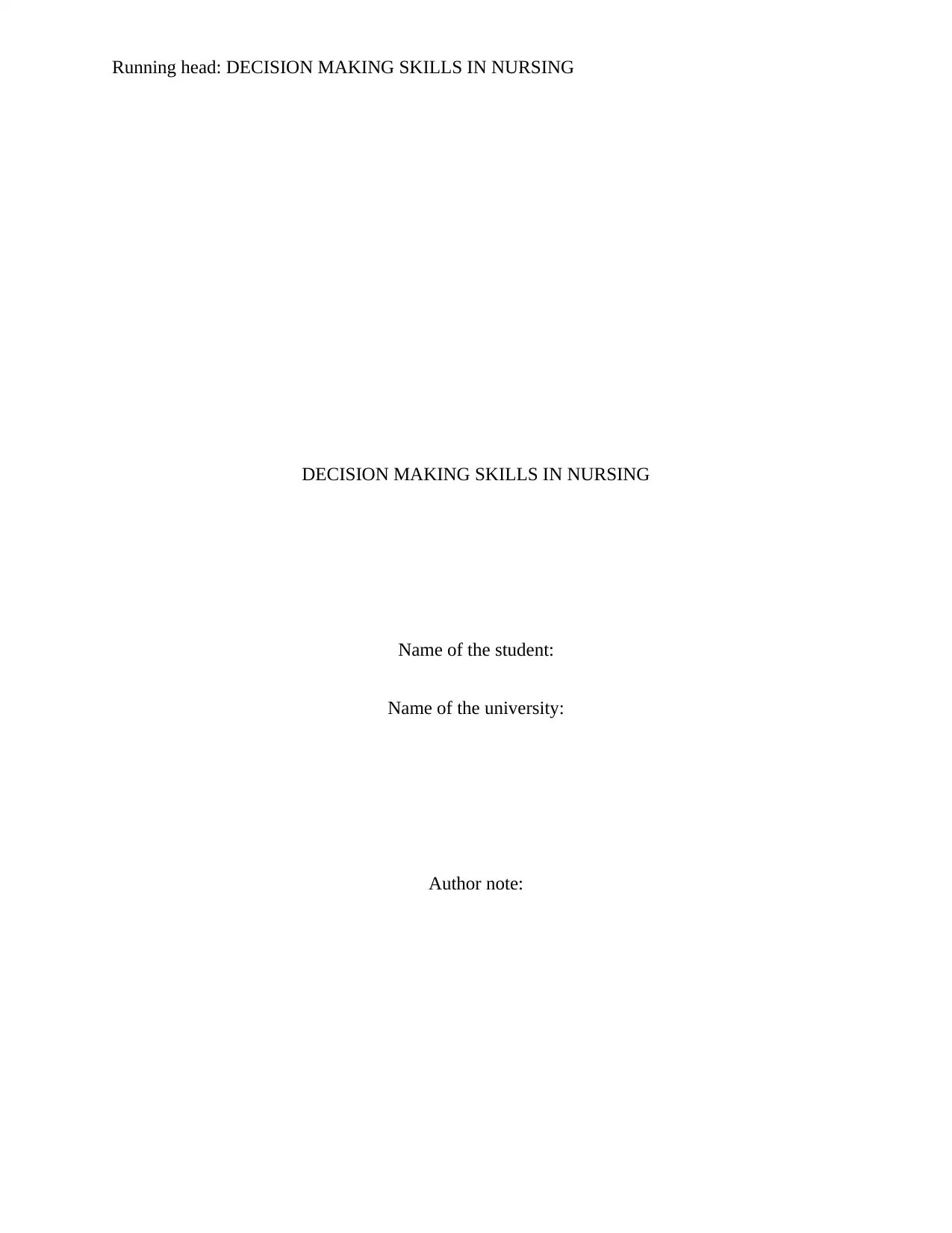
Running head: DECISION MAKING SKILLS IN NURSING
DECISION MAKING SKILLS IN NURSING
Name of the student:
Name of the university:
Author note:
DECISION MAKING SKILLS IN NURSING
Name of the student:
Name of the university:
Author note:
Paraphrase This Document
Need a fresh take? Get an instant paraphrase of this document with our AI Paraphraser
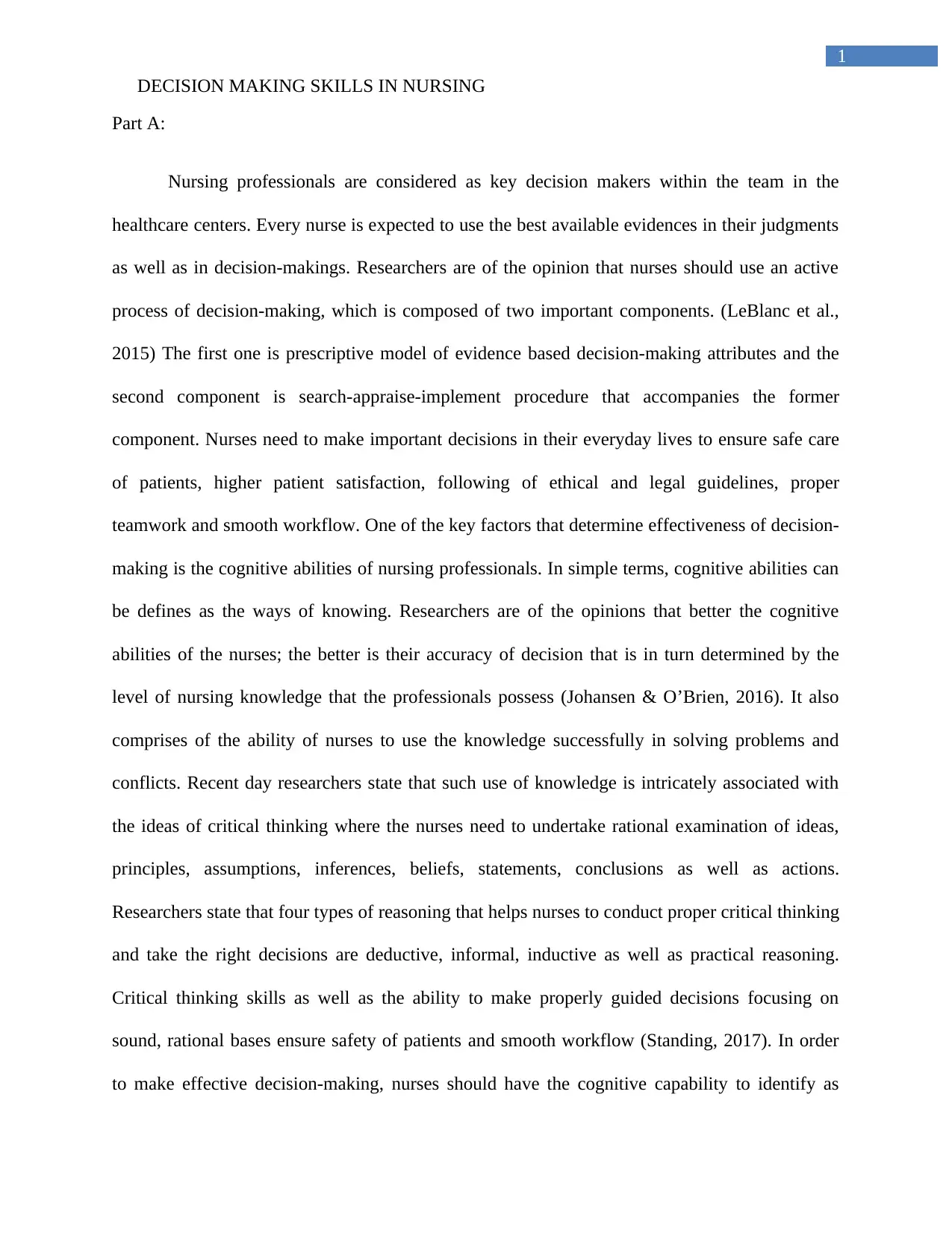
1
DECISION MAKING SKILLS IN NURSING
Part A:
Nursing professionals are considered as key decision makers within the team in the
healthcare centers. Every nurse is expected to use the best available evidences in their judgments
as well as in decision-makings. Researchers are of the opinion that nurses should use an active
process of decision-making, which is composed of two important components. (LeBlanc et al.,
2015) The first one is prescriptive model of evidence based decision-making attributes and the
second component is search-appraise-implement procedure that accompanies the former
component. Nurses need to make important decisions in their everyday lives to ensure safe care
of patients, higher patient satisfaction, following of ethical and legal guidelines, proper
teamwork and smooth workflow. One of the key factors that determine effectiveness of decision-
making is the cognitive abilities of nursing professionals. In simple terms, cognitive abilities can
be defines as the ways of knowing. Researchers are of the opinions that better the cognitive
abilities of the nurses; the better is their accuracy of decision that is in turn determined by the
level of nursing knowledge that the professionals possess (Johansen & O’Brien, 2016). It also
comprises of the ability of nurses to use the knowledge successfully in solving problems and
conflicts. Recent day researchers state that such use of knowledge is intricately associated with
the ideas of critical thinking where the nurses need to undertake rational examination of ideas,
principles, assumptions, inferences, beliefs, statements, conclusions as well as actions.
Researchers state that four types of reasoning that helps nurses to conduct proper critical thinking
and take the right decisions are deductive, informal, inductive as well as practical reasoning.
Critical thinking skills as well as the ability to make properly guided decisions focusing on
sound, rational bases ensure safety of patients and smooth workflow (Standing, 2017). In order
to make effective decision-making, nurses should have the cognitive capability to identify as
DECISION MAKING SKILLS IN NURSING
Part A:
Nursing professionals are considered as key decision makers within the team in the
healthcare centers. Every nurse is expected to use the best available evidences in their judgments
as well as in decision-makings. Researchers are of the opinion that nurses should use an active
process of decision-making, which is composed of two important components. (LeBlanc et al.,
2015) The first one is prescriptive model of evidence based decision-making attributes and the
second component is search-appraise-implement procedure that accompanies the former
component. Nurses need to make important decisions in their everyday lives to ensure safe care
of patients, higher patient satisfaction, following of ethical and legal guidelines, proper
teamwork and smooth workflow. One of the key factors that determine effectiveness of decision-
making is the cognitive abilities of nursing professionals. In simple terms, cognitive abilities can
be defines as the ways of knowing. Researchers are of the opinions that better the cognitive
abilities of the nurses; the better is their accuracy of decision that is in turn determined by the
level of nursing knowledge that the professionals possess (Johansen & O’Brien, 2016). It also
comprises of the ability of nurses to use the knowledge successfully in solving problems and
conflicts. Recent day researchers state that such use of knowledge is intricately associated with
the ideas of critical thinking where the nurses need to undertake rational examination of ideas,
principles, assumptions, inferences, beliefs, statements, conclusions as well as actions.
Researchers state that four types of reasoning that helps nurses to conduct proper critical thinking
and take the right decisions are deductive, informal, inductive as well as practical reasoning.
Critical thinking skills as well as the ability to make properly guided decisions focusing on
sound, rational bases ensure safety of patients and smooth workflow (Standing, 2017). In order
to make effective decision-making, nurses should have the cognitive capability to identify as
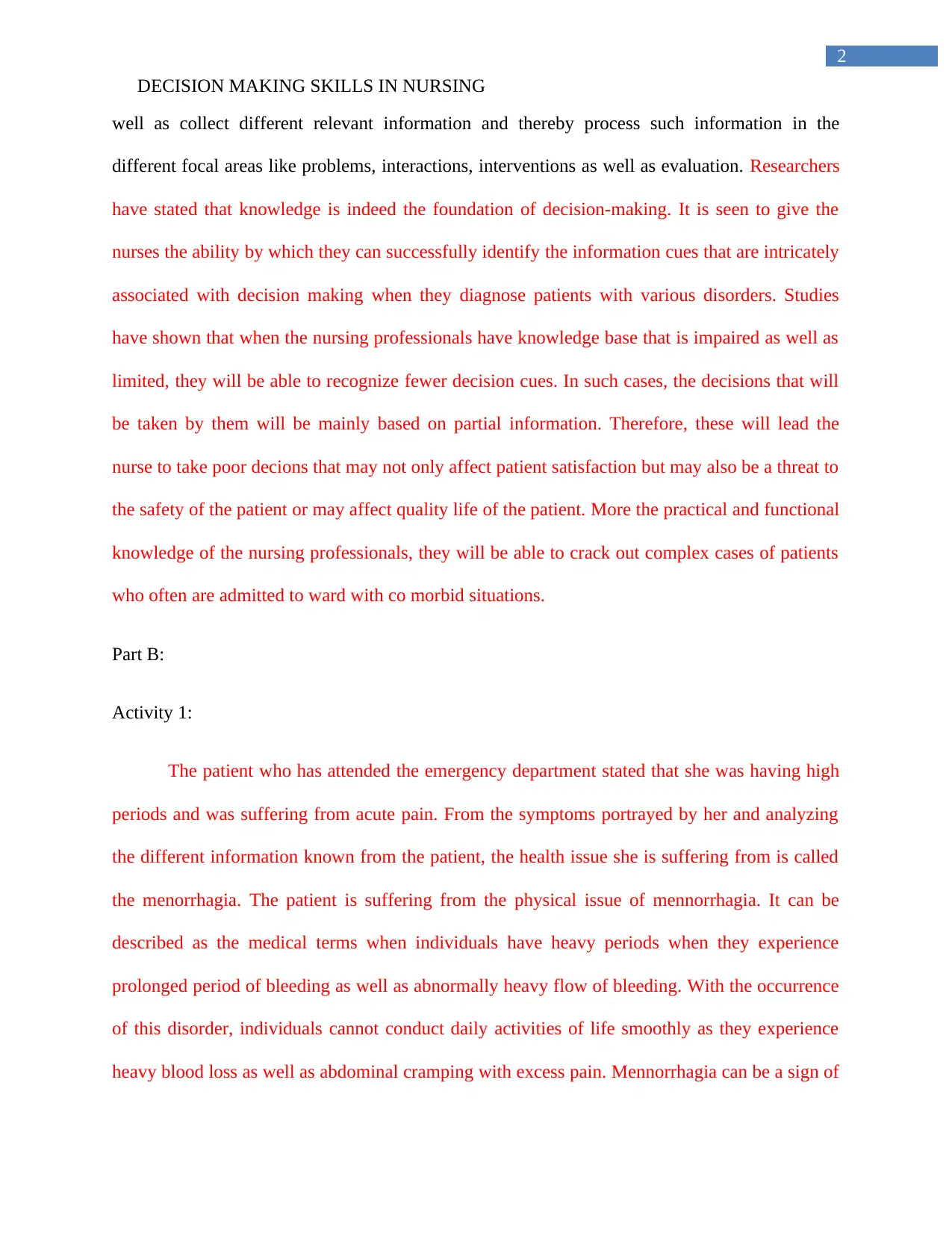
2
DECISION MAKING SKILLS IN NURSING
well as collect different relevant information and thereby process such information in the
different focal areas like problems, interactions, interventions as well as evaluation. Researchers
have stated that knowledge is indeed the foundation of decision-making. It is seen to give the
nurses the ability by which they can successfully identify the information cues that are intricately
associated with decision making when they diagnose patients with various disorders. Studies
have shown that when the nursing professionals have knowledge base that is impaired as well as
limited, they will be able to recognize fewer decision cues. In such cases, the decisions that will
be taken by them will be mainly based on partial information. Therefore, these will lead the
nurse to take poor decions that may not only affect patient satisfaction but may also be a threat to
the safety of the patient or may affect quality life of the patient. More the practical and functional
knowledge of the nursing professionals, they will be able to crack out complex cases of patients
who often are admitted to ward with co morbid situations.
Part B:
Activity 1:
The patient who has attended the emergency department stated that she was having high
periods and was suffering from acute pain. From the symptoms portrayed by her and analyzing
the different information known from the patient, the health issue she is suffering from is called
the menorrhagia. The patient is suffering from the physical issue of mennorrhagia. It can be
described as the medical terms when individuals have heavy periods when they experience
prolonged period of bleeding as well as abnormally heavy flow of bleeding. With the occurrence
of this disorder, individuals cannot conduct daily activities of life smoothly as they experience
heavy blood loss as well as abdominal cramping with excess pain. Mennorrhagia can be a sign of
DECISION MAKING SKILLS IN NURSING
well as collect different relevant information and thereby process such information in the
different focal areas like problems, interactions, interventions as well as evaluation. Researchers
have stated that knowledge is indeed the foundation of decision-making. It is seen to give the
nurses the ability by which they can successfully identify the information cues that are intricately
associated with decision making when they diagnose patients with various disorders. Studies
have shown that when the nursing professionals have knowledge base that is impaired as well as
limited, they will be able to recognize fewer decision cues. In such cases, the decisions that will
be taken by them will be mainly based on partial information. Therefore, these will lead the
nurse to take poor decions that may not only affect patient satisfaction but may also be a threat to
the safety of the patient or may affect quality life of the patient. More the practical and functional
knowledge of the nursing professionals, they will be able to crack out complex cases of patients
who often are admitted to ward with co morbid situations.
Part B:
Activity 1:
The patient who has attended the emergency department stated that she was having high
periods and was suffering from acute pain. From the symptoms portrayed by her and analyzing
the different information known from the patient, the health issue she is suffering from is called
the menorrhagia. The patient is suffering from the physical issue of mennorrhagia. It can be
described as the medical terms when individuals have heavy periods when they experience
prolonged period of bleeding as well as abnormally heavy flow of bleeding. With the occurrence
of this disorder, individuals cannot conduct daily activities of life smoothly as they experience
heavy blood loss as well as abdominal cramping with excess pain. Mennorrhagia can be a sign of
⊘ This is a preview!⊘
Do you want full access?
Subscribe today to unlock all pages.

Trusted by 1+ million students worldwide
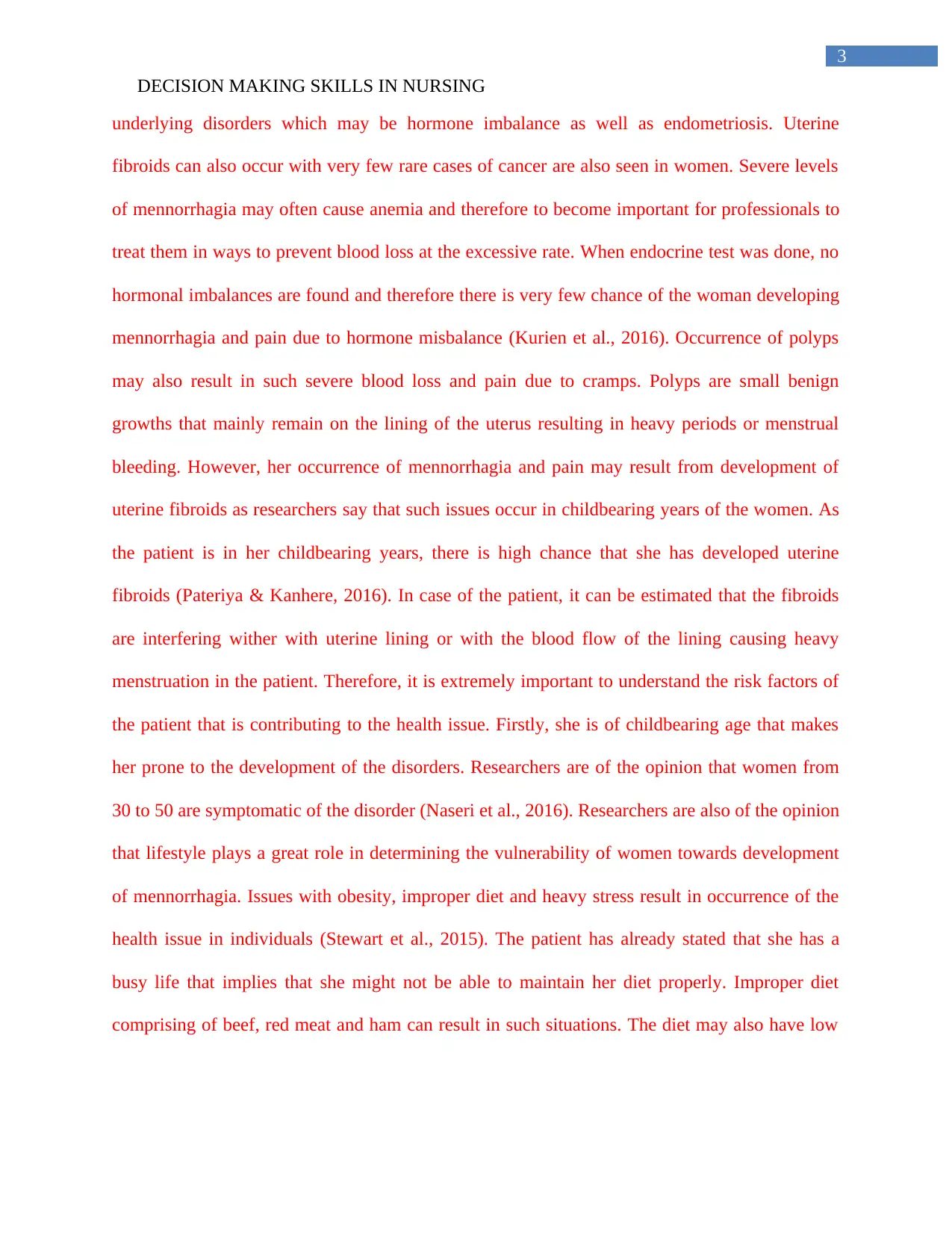
3
DECISION MAKING SKILLS IN NURSING
underlying disorders which may be hormone imbalance as well as endometriosis. Uterine
fibroids can also occur with very few rare cases of cancer are also seen in women. Severe levels
of mennorrhagia may often cause anemia and therefore to become important for professionals to
treat them in ways to prevent blood loss at the excessive rate. When endocrine test was done, no
hormonal imbalances are found and therefore there is very few chance of the woman developing
mennorrhagia and pain due to hormone misbalance (Kurien et al., 2016). Occurrence of polyps
may also result in such severe blood loss and pain due to cramps. Polyps are small benign
growths that mainly remain on the lining of the uterus resulting in heavy periods or menstrual
bleeding. However, her occurrence of mennorrhagia and pain may result from development of
uterine fibroids as researchers say that such issues occur in childbearing years of the women. As
the patient is in her childbearing years, there is high chance that she has developed uterine
fibroids (Pateriya & Kanhere, 2016). In case of the patient, it can be estimated that the fibroids
are interfering wither with uterine lining or with the blood flow of the lining causing heavy
menstruation in the patient. Therefore, it is extremely important to understand the risk factors of
the patient that is contributing to the health issue. Firstly, she is of childbearing age that makes
her prone to the development of the disorders. Researchers are of the opinion that women from
30 to 50 are symptomatic of the disorder (Naseri et al., 2016). Researchers are also of the opinion
that lifestyle plays a great role in determining the vulnerability of women towards development
of mennorrhagia. Issues with obesity, improper diet and heavy stress result in occurrence of the
health issue in individuals (Stewart et al., 2015). The patient has already stated that she has a
busy life that implies that she might not be able to maintain her diet properly. Improper diet
comprising of beef, red meat and ham can result in such situations. The diet may also have low
DECISION MAKING SKILLS IN NURSING
underlying disorders which may be hormone imbalance as well as endometriosis. Uterine
fibroids can also occur with very few rare cases of cancer are also seen in women. Severe levels
of mennorrhagia may often cause anemia and therefore to become important for professionals to
treat them in ways to prevent blood loss at the excessive rate. When endocrine test was done, no
hormonal imbalances are found and therefore there is very few chance of the woman developing
mennorrhagia and pain due to hormone misbalance (Kurien et al., 2016). Occurrence of polyps
may also result in such severe blood loss and pain due to cramps. Polyps are small benign
growths that mainly remain on the lining of the uterus resulting in heavy periods or menstrual
bleeding. However, her occurrence of mennorrhagia and pain may result from development of
uterine fibroids as researchers say that such issues occur in childbearing years of the women. As
the patient is in her childbearing years, there is high chance that she has developed uterine
fibroids (Pateriya & Kanhere, 2016). In case of the patient, it can be estimated that the fibroids
are interfering wither with uterine lining or with the blood flow of the lining causing heavy
menstruation in the patient. Therefore, it is extremely important to understand the risk factors of
the patient that is contributing to the health issue. Firstly, she is of childbearing age that makes
her prone to the development of the disorders. Researchers are of the opinion that women from
30 to 50 are symptomatic of the disorder (Naseri et al., 2016). Researchers are also of the opinion
that lifestyle plays a great role in determining the vulnerability of women towards development
of mennorrhagia. Issues with obesity, improper diet and heavy stress result in occurrence of the
health issue in individuals (Stewart et al., 2015). The patient has already stated that she has a
busy life that implies that she might not be able to maintain her diet properly. Improper diet
comprising of beef, red meat and ham can result in such situations. The diet may also have low
Paraphrase This Document
Need a fresh take? Get an instant paraphrase of this document with our AI Paraphraser
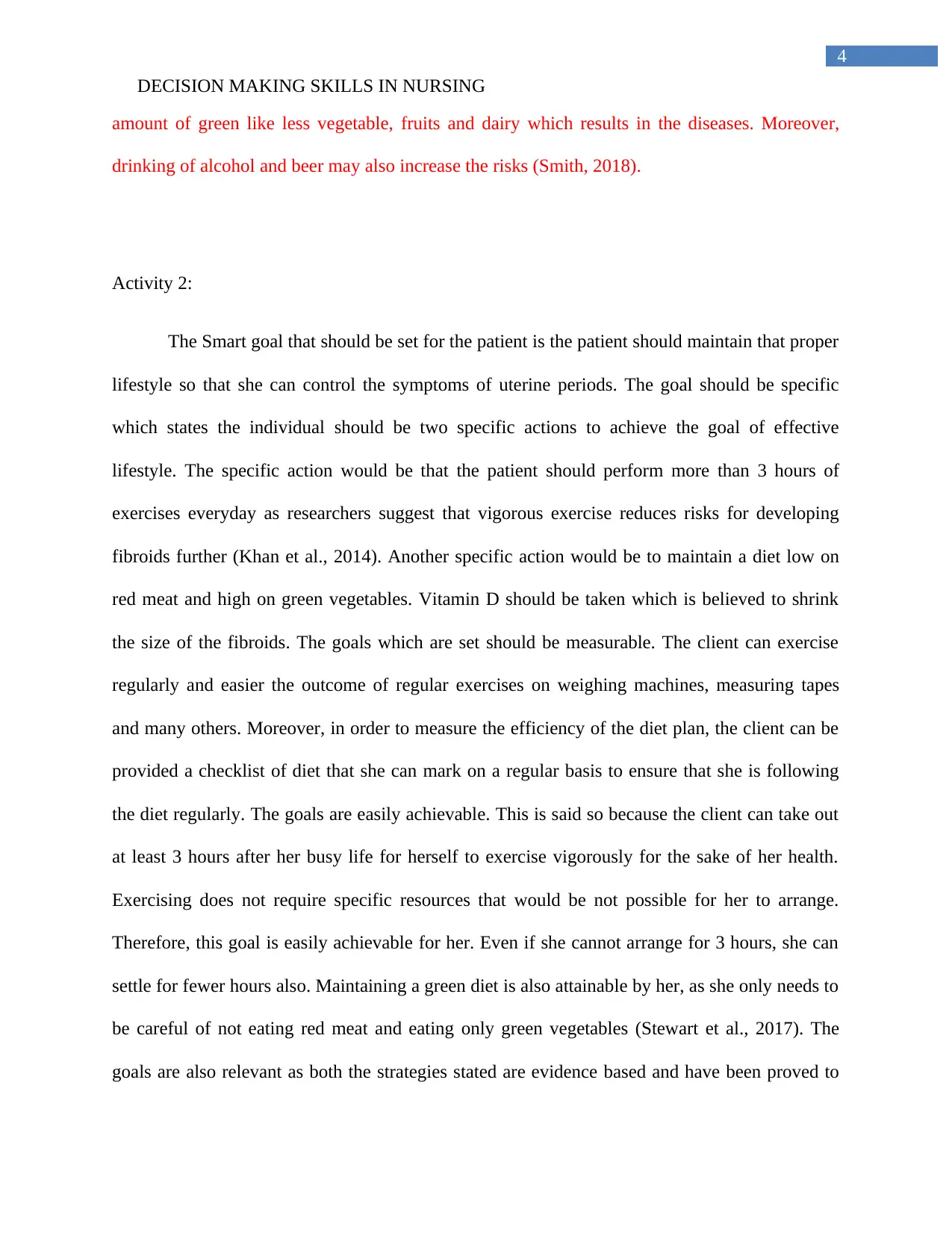
4
DECISION MAKING SKILLS IN NURSING
amount of green like less vegetable, fruits and dairy which results in the diseases. Moreover,
drinking of alcohol and beer may also increase the risks (Smith, 2018).
Activity 2:
The Smart goal that should be set for the patient is the patient should maintain that proper
lifestyle so that she can control the symptoms of uterine periods. The goal should be specific
which states the individual should be two specific actions to achieve the goal of effective
lifestyle. The specific action would be that the patient should perform more than 3 hours of
exercises everyday as researchers suggest that vigorous exercise reduces risks for developing
fibroids further (Khan et al., 2014). Another specific action would be to maintain a diet low on
red meat and high on green vegetables. Vitamin D should be taken which is believed to shrink
the size of the fibroids. The goals which are set should be measurable. The client can exercise
regularly and easier the outcome of regular exercises on weighing machines, measuring tapes
and many others. Moreover, in order to measure the efficiency of the diet plan, the client can be
provided a checklist of diet that she can mark on a regular basis to ensure that she is following
the diet regularly. The goals are easily achievable. This is said so because the client can take out
at least 3 hours after her busy life for herself to exercise vigorously for the sake of her health.
Exercising does not require specific resources that would be not possible for her to arrange.
Therefore, this goal is easily achievable for her. Even if she cannot arrange for 3 hours, she can
settle for fewer hours also. Maintaining a green diet is also attainable by her, as she only needs to
be careful of not eating red meat and eating only green vegetables (Stewart et al., 2017). The
goals are also relevant as both the strategies stated are evidence based and have been proved to
DECISION MAKING SKILLS IN NURSING
amount of green like less vegetable, fruits and dairy which results in the diseases. Moreover,
drinking of alcohol and beer may also increase the risks (Smith, 2018).
Activity 2:
The Smart goal that should be set for the patient is the patient should maintain that proper
lifestyle so that she can control the symptoms of uterine periods. The goal should be specific
which states the individual should be two specific actions to achieve the goal of effective
lifestyle. The specific action would be that the patient should perform more than 3 hours of
exercises everyday as researchers suggest that vigorous exercise reduces risks for developing
fibroids further (Khan et al., 2014). Another specific action would be to maintain a diet low on
red meat and high on green vegetables. Vitamin D should be taken which is believed to shrink
the size of the fibroids. The goals which are set should be measurable. The client can exercise
regularly and easier the outcome of regular exercises on weighing machines, measuring tapes
and many others. Moreover, in order to measure the efficiency of the diet plan, the client can be
provided a checklist of diet that she can mark on a regular basis to ensure that she is following
the diet regularly. The goals are easily achievable. This is said so because the client can take out
at least 3 hours after her busy life for herself to exercise vigorously for the sake of her health.
Exercising does not require specific resources that would be not possible for her to arrange.
Therefore, this goal is easily achievable for her. Even if she cannot arrange for 3 hours, she can
settle for fewer hours also. Maintaining a green diet is also attainable by her, as she only needs to
be careful of not eating red meat and eating only green vegetables (Stewart et al., 2017). The
goals are also relevant as both the strategies stated are evidence based and have been proved to
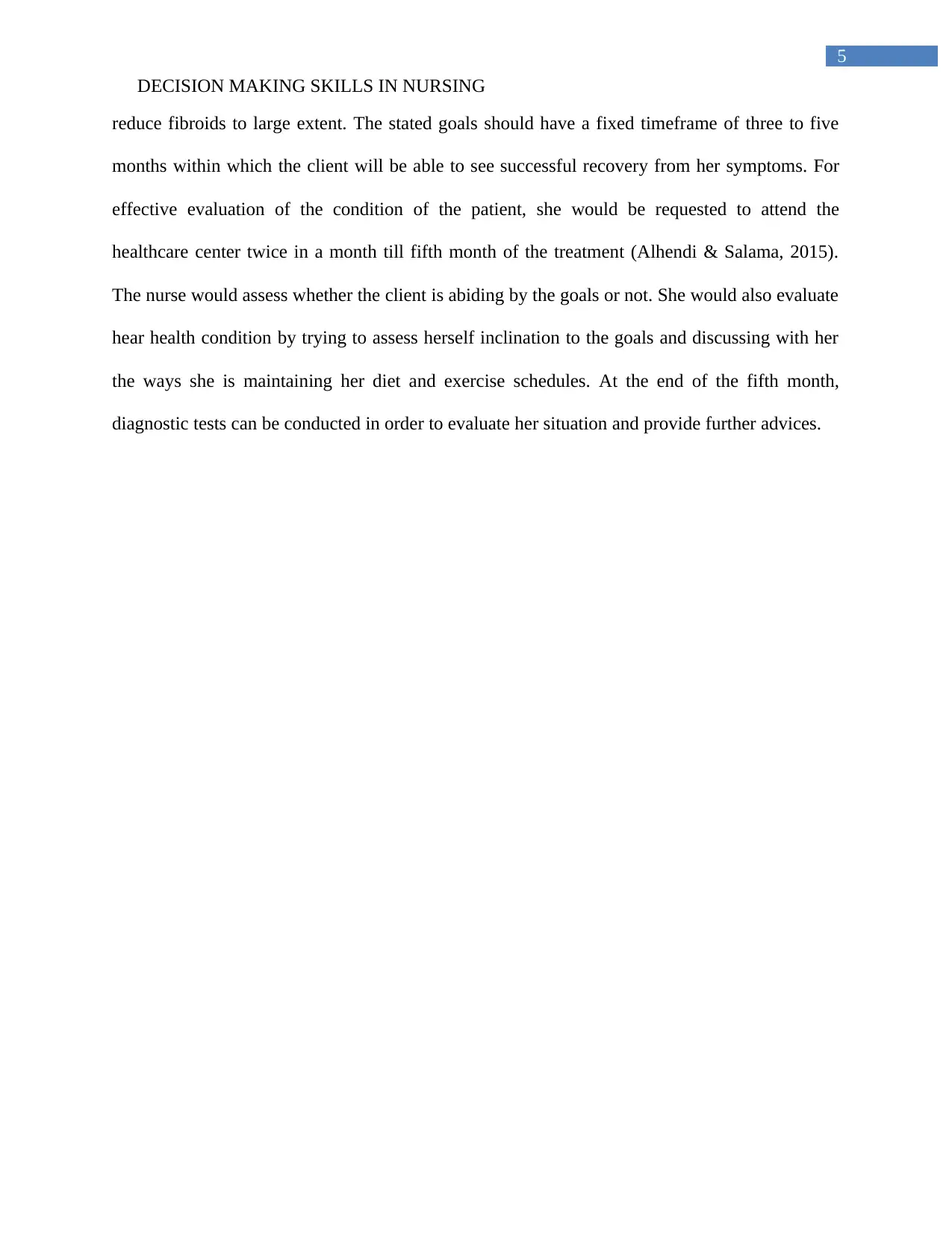
5
DECISION MAKING SKILLS IN NURSING
reduce fibroids to large extent. The stated goals should have a fixed timeframe of three to five
months within which the client will be able to see successful recovery from her symptoms. For
effective evaluation of the condition of the patient, she would be requested to attend the
healthcare center twice in a month till fifth month of the treatment (Alhendi & Salama, 2015).
The nurse would assess whether the client is abiding by the goals or not. She would also evaluate
hear health condition by trying to assess herself inclination to the goals and discussing with her
the ways she is maintaining her diet and exercise schedules. At the end of the fifth month,
diagnostic tests can be conducted in order to evaluate her situation and provide further advices.
DECISION MAKING SKILLS IN NURSING
reduce fibroids to large extent. The stated goals should have a fixed timeframe of three to five
months within which the client will be able to see successful recovery from her symptoms. For
effective evaluation of the condition of the patient, she would be requested to attend the
healthcare center twice in a month till fifth month of the treatment (Alhendi & Salama, 2015).
The nurse would assess whether the client is abiding by the goals or not. She would also evaluate
hear health condition by trying to assess herself inclination to the goals and discussing with her
the ways she is maintaining her diet and exercise schedules. At the end of the fifth month,
diagnostic tests can be conducted in order to evaluate her situation and provide further advices.
⊘ This is a preview!⊘
Do you want full access?
Subscribe today to unlock all pages.

Trusted by 1+ million students worldwide
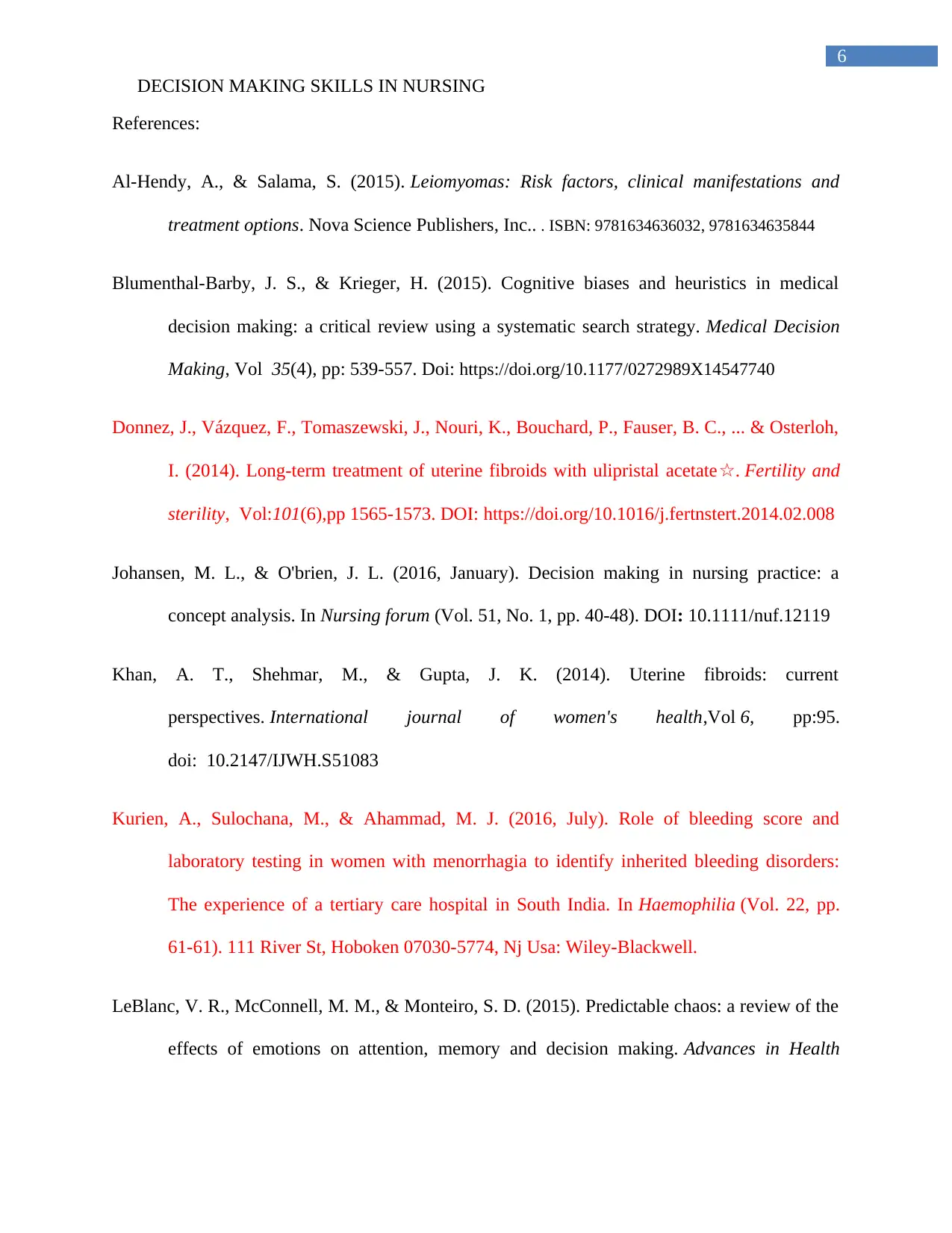
6
DECISION MAKING SKILLS IN NURSING
References:
Al-Hendy, A., & Salama, S. (2015). Leiomyomas: Risk factors, clinical manifestations and
treatment options. Nova Science Publishers, Inc.. . ISBN: 9781634636032, 9781634635844
Blumenthal-Barby, J. S., & Krieger, H. (2015). Cognitive biases and heuristics in medical
decision making: a critical review using a systematic search strategy. Medical Decision
Making, Vol 35(4), pp: 539-557. Doi: https://doi.org/10.1177/0272989X14547740
Donnez, J., Vázquez, F., Tomaszewski, J., Nouri, K., Bouchard, P., Fauser, B. C., ... & Osterloh,
I. (2014). Long-term treatment of uterine fibroids with ulipristal acetate☆. Fertility and
sterility, Vol:101(6),pp 1565-1573. DOI: https://doi.org/10.1016/j.fertnstert.2014.02.008
Johansen, M. L., & O'brien, J. L. (2016, January). Decision making in nursing practice: a
concept analysis. In Nursing forum (Vol. 51, No. 1, pp. 40-48). DOI: 10.1111/nuf.12119
Khan, A. T., Shehmar, M., & Gupta, J. K. (2014). Uterine fibroids: current
perspectives. International journal of women's health,Vol 6, pp:95.
doi: 10.2147/IJWH.S51083
Kurien, A., Sulochana, M., & Ahammad, M. J. (2016, July). Role of bleeding score and
laboratory testing in women with menorrhagia to identify inherited bleeding disorders:
The experience of a tertiary care hospital in South India. In Haemophilia (Vol. 22, pp.
61-61). 111 River St, Hoboken 07030-5774, Nj Usa: Wiley-Blackwell.
LeBlanc, V. R., McConnell, M. M., & Monteiro, S. D. (2015). Predictable chaos: a review of the
effects of emotions on attention, memory and decision making. Advances in Health
DECISION MAKING SKILLS IN NURSING
References:
Al-Hendy, A., & Salama, S. (2015). Leiomyomas: Risk factors, clinical manifestations and
treatment options. Nova Science Publishers, Inc.. . ISBN: 9781634636032, 9781634635844
Blumenthal-Barby, J. S., & Krieger, H. (2015). Cognitive biases and heuristics in medical
decision making: a critical review using a systematic search strategy. Medical Decision
Making, Vol 35(4), pp: 539-557. Doi: https://doi.org/10.1177/0272989X14547740
Donnez, J., Vázquez, F., Tomaszewski, J., Nouri, K., Bouchard, P., Fauser, B. C., ... & Osterloh,
I. (2014). Long-term treatment of uterine fibroids with ulipristal acetate☆. Fertility and
sterility, Vol:101(6),pp 1565-1573. DOI: https://doi.org/10.1016/j.fertnstert.2014.02.008
Johansen, M. L., & O'brien, J. L. (2016, January). Decision making in nursing practice: a
concept analysis. In Nursing forum (Vol. 51, No. 1, pp. 40-48). DOI: 10.1111/nuf.12119
Khan, A. T., Shehmar, M., & Gupta, J. K. (2014). Uterine fibroids: current
perspectives. International journal of women's health,Vol 6, pp:95.
doi: 10.2147/IJWH.S51083
Kurien, A., Sulochana, M., & Ahammad, M. J. (2016, July). Role of bleeding score and
laboratory testing in women with menorrhagia to identify inherited bleeding disorders:
The experience of a tertiary care hospital in South India. In Haemophilia (Vol. 22, pp.
61-61). 111 River St, Hoboken 07030-5774, Nj Usa: Wiley-Blackwell.
LeBlanc, V. R., McConnell, M. M., & Monteiro, S. D. (2015). Predictable chaos: a review of the
effects of emotions on attention, memory and decision making. Advances in Health
Paraphrase This Document
Need a fresh take? Get an instant paraphrase of this document with our AI Paraphraser
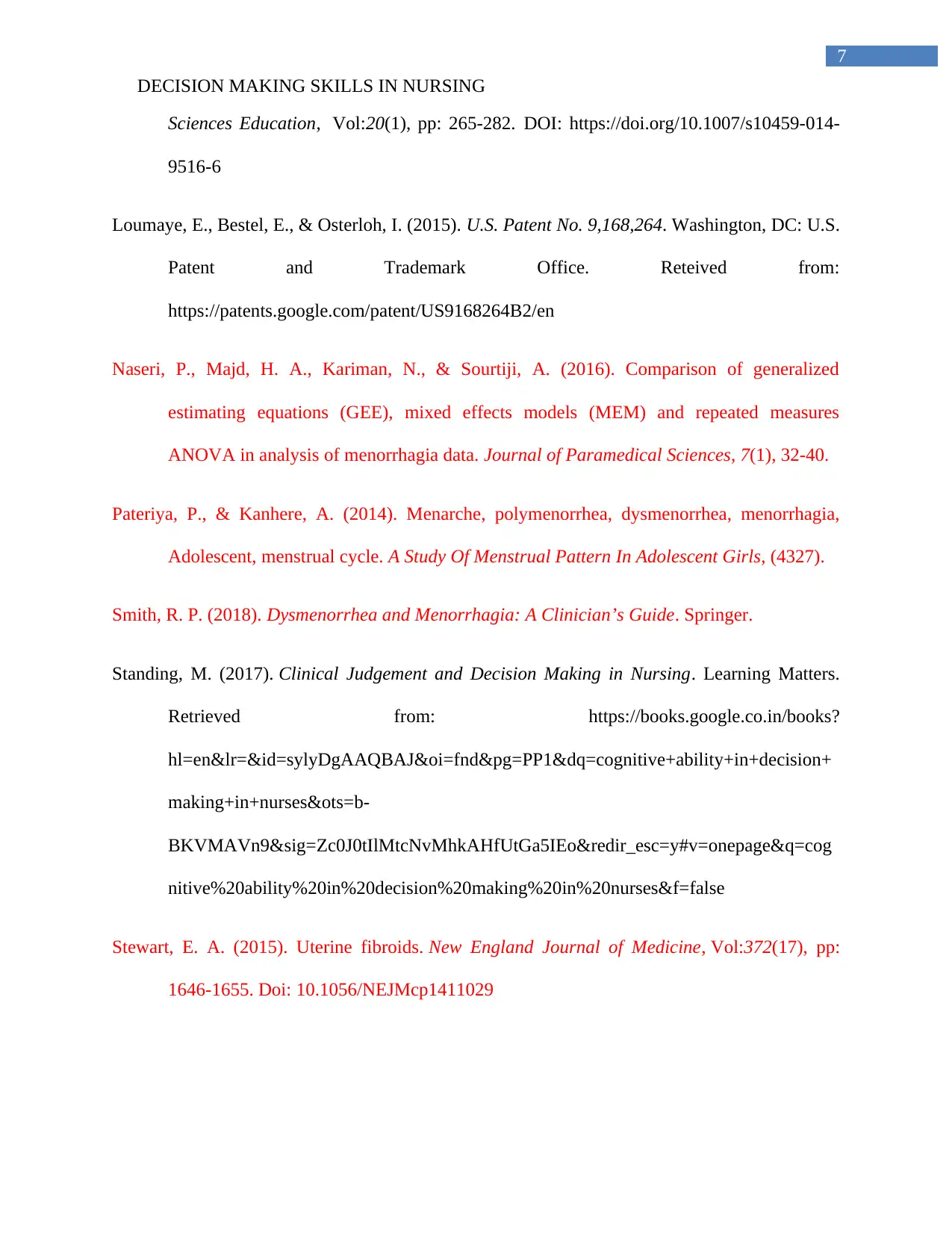
7
DECISION MAKING SKILLS IN NURSING
Sciences Education, Vol:20(1), pp: 265-282. DOI: https://doi.org/10.1007/s10459-014-
9516-6
Loumaye, E., Bestel, E., & Osterloh, I. (2015). U.S. Patent No. 9,168,264. Washington, DC: U.S.
Patent and Trademark Office. Reteived from:
https://patents.google.com/patent/US9168264B2/en
Naseri, P., Majd, H. A., Kariman, N., & Sourtiji, A. (2016). Comparison of generalized
estimating equations (GEE), mixed effects models (MEM) and repeated measures
ANOVA in analysis of menorrhagia data. Journal of Paramedical Sciences, 7(1), 32-40.
Pateriya, P., & Kanhere, A. (2014). Menarche, polymenorrhea, dysmenorrhea, menorrhagia,
Adolescent, menstrual cycle. A Study Of Menstrual Pattern In Adolescent Girls, (4327).
Smith, R. P. (2018). Dysmenorrhea and Menorrhagia: A Clinician’s Guide. Springer.
Standing, M. (2017). Clinical Judgement and Decision Making in Nursing. Learning Matters.
Retrieved from: https://books.google.co.in/books?
hl=en&lr=&id=sylyDgAAQBAJ&oi=fnd&pg=PP1&dq=cognitive+ability+in+decision+
making+in+nurses&ots=b-
BKVMAVn9&sig=Zc0J0tIlMtcNvMhkAHfUtGa5IEo&redir_esc=y#v=onepage&q=cog
nitive%20ability%20in%20decision%20making%20in%20nurses&f=false
Stewart, E. A. (2015). Uterine fibroids. New England Journal of Medicine, Vol:372(17), pp:
1646-1655. Doi: 10.1056/NEJMcp1411029
DECISION MAKING SKILLS IN NURSING
Sciences Education, Vol:20(1), pp: 265-282. DOI: https://doi.org/10.1007/s10459-014-
9516-6
Loumaye, E., Bestel, E., & Osterloh, I. (2015). U.S. Patent No. 9,168,264. Washington, DC: U.S.
Patent and Trademark Office. Reteived from:
https://patents.google.com/patent/US9168264B2/en
Naseri, P., Majd, H. A., Kariman, N., & Sourtiji, A. (2016). Comparison of generalized
estimating equations (GEE), mixed effects models (MEM) and repeated measures
ANOVA in analysis of menorrhagia data. Journal of Paramedical Sciences, 7(1), 32-40.
Pateriya, P., & Kanhere, A. (2014). Menarche, polymenorrhea, dysmenorrhea, menorrhagia,
Adolescent, menstrual cycle. A Study Of Menstrual Pattern In Adolescent Girls, (4327).
Smith, R. P. (2018). Dysmenorrhea and Menorrhagia: A Clinician’s Guide. Springer.
Standing, M. (2017). Clinical Judgement and Decision Making in Nursing. Learning Matters.
Retrieved from: https://books.google.co.in/books?
hl=en&lr=&id=sylyDgAAQBAJ&oi=fnd&pg=PP1&dq=cognitive+ability+in+decision+
making+in+nurses&ots=b-
BKVMAVn9&sig=Zc0J0tIlMtcNvMhkAHfUtGa5IEo&redir_esc=y#v=onepage&q=cog
nitive%20ability%20in%20decision%20making%20in%20nurses&f=false
Stewart, E. A. (2015). Uterine fibroids. New England Journal of Medicine, Vol:372(17), pp:
1646-1655. Doi: 10.1056/NEJMcp1411029

8
DECISION MAKING SKILLS IN NURSING
Stewart, E. A., Cookson, C., Gandolfo, R. A., & Schulze‐Rath, R. (2017). Epidemiology of
uterine fibroids: a systematic review. BJOG: An International Journal of Obstetrics &
Gynaecology DOI: 10.1111/1471-0528.14640
DECISION MAKING SKILLS IN NURSING
Stewart, E. A., Cookson, C., Gandolfo, R. A., & Schulze‐Rath, R. (2017). Epidemiology of
uterine fibroids: a systematic review. BJOG: An International Journal of Obstetrics &
Gynaecology DOI: 10.1111/1471-0528.14640
⊘ This is a preview!⊘
Do you want full access?
Subscribe today to unlock all pages.

Trusted by 1+ million students worldwide
1 out of 9
Related Documents
Your All-in-One AI-Powered Toolkit for Academic Success.
+13062052269
info@desklib.com
Available 24*7 on WhatsApp / Email
![[object Object]](/_next/static/media/star-bottom.7253800d.svg)
Unlock your academic potential
Copyright © 2020–2025 A2Z Services. All Rights Reserved. Developed and managed by ZUCOL.





